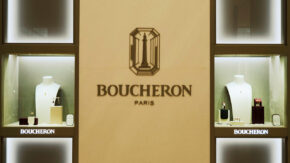They might not make the grade for jewelry, but industrial diamonds have been amping up everything from equipment and electronics to cosmetics.
You’ve got to hand it to diamonds. As a complex material made of a single abundant element — carbon — this mineral is truly versatile. The gem-quality specimens we set into jewelry account for just a small fraction of diamond use; most mined and lab-grown stones serve industrial purposes, such as high-precision cutting, semiconductor materials, the manufacture of instruments, and even sound production.
Diamond is hard, durable, chemically inert, insoluble in water, and electrically non-conductive, so diamond tools and components remain sharp and precise longer than other materials.
The sound of progress
Remember the turntable needle from back in the day? The best ones were made of industrial-grade diamond and looked nothing like the sparklers we know. Fast-forward to the 21st century, and diamonds are still making their mark in the hi-fi space.
Some years ago, De Beers industrial-diamond unit Element Six Technologies partnered with leading British audio brand Bowers & Wilkins to develop the world’s first synthetic-diamond tweeter dome — a loudspeaker component that extends high-frequency audio. It features in the latter company’s 800 Series Diamond speakers, which are in use at some of the world’s most famous recording studios, including London’s Abbey Road. In 2012, the two companies jointly received the UK’s prominent Queen’s Award for Enterprise in Innovation for their collaboration. They have since teamed up to create speakers for select BMW vehicles.
Next-level beauty
The cosmetic industry is another frequent user of industrial diamonds. Diamond-coated wands in the hands of a skillful dermatologist can perform microdermabrasion procedures. That might sound painful, but don’t worry: The diamonds are ground down so fine that they don’t damage the skin.
One particular beauty product that diamonds have improved is the nail file. Coating a stainless-steel file with diamond dust ensures that nails get a smooth, even finish. The file stays sharp for a lifetime, thus eliminating waste. For comparison, the common brown-paper nail files — which utilize ground garnet — usually last a month, tops.
And diamonds aren’t just for equipment. As Beyoncé says in her song “Upgrade U,” you can get a “diamond cream facial.” Cosmetic companies use diamond powder in a range of face products. Because of their inherent refractive nature, finely crushed diamonds help brighten the skin. And in nail polish, they contribute not only shine, but also a protective hardness, making for strong, shimmering nails.
Applied science
Because of diamonds’ numerous properties, lots of US research institutions, universities, colleges and corporations have devoted resources to studying them. I recently attended a university symposium on diamonds and quantum physics, where I met Dr. Val Konovalov, a lead scientist at Applied Diamond Inc. (ADI). Konovalov introduced me to company sales and marketing manager Victor H. Tabeling, who invited me for a tour of the facility.
When ADI started two generations ago, its first product line was precision knives, which it no longer makes. Today, it custom-manufactures diamond applications for several tech and communications companies. It also makes products for fields such as aerospace and defense, high-powered electronics, lasers, optics, materials, physics, and energy.
I wasn’t sure what to expect from the tour. The company’s projects are mostly hush-hush, as it has a number of high-profile clients — among them the US Department of Energy. The building itself is so nondescript that I rode by it twice. Once inside, I didn’t see a single bit of shine or sparkle — a sure indication you’re dealing with industrial material. But the lack of bling didn’t lessen my awe in the least. In fact, I came away more impressed with diamonds than ever.
ADI grows its own chemical vapor deposition (CVD) diamonds, says Tabeling, as well as sourcing natural ones. The latter are better suited to applications that require grinding the diamonds, he explains, “because of growth patterns.” The company dopes some of its diamonds “with boron, nitrogen, and other contaminants for our quantum customers and experiments,” he adds. “Since diamonds are electrically resistive, [the boron helps with] electrical conductivity.”
The future of diamond applications is promising. We can likely expect more advances in the tech, energy, entertainment and communication spaces, so stay tuned!
Image: Bowers & Wilkins



